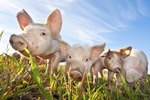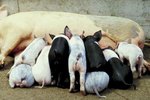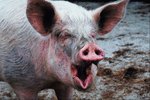
"Hog" is the generic term for a full-grown pig and refers to several types of swine. One of the earliest animals to be domesticated, hogs come in several varieties. From farm pigs raised for their meat to feral hogs, they can be found all across the country.
Yorkshire
The most popular breed of pig in the United States is the American Yorkshire hog. Yorkshires are large and muscular, raised for their lean meat. They’re what most people picture when they think of pigs: pale pink, pointy ears, snub nose and curly tail. They’re capable of producing large litters and known for being excellent mothers.
Duroc
The second-most popular breed of pig in the United States is the Duroc. Durocs are considered “red” pigs, but come in colors from light golden yellow to dark mahogany. They’re large pigs with drooping, floppy ears. Due to their lean meat and fast growth rate, Duroc pigs are often crossbred with other types of pigs to improve meat quality.
Hampshire
The Hampshire is thought to be the oldest breed of American hog. They’re black with a broad white ring around their middle, encompassing the front legs and shoulders. Due to their unique coloration, they were once called Saddlebacks or Ring Middles. Eventually the name "Hampshire" was settled upon because they came from Hampshire County in England. Lean and muscular, Hampshires are raised for their meat.
Guinea Hog
Once one of the most popular breeds of pigs in the United States, the Guinea hog is now rare. Originally brought from West Africa, they became popular in the United States for their small size and affable personality. They’re recognized by their solid black coat, curly tail and pointy ears. They are fatter than most modern meat hogs, but are excellent for pest control, grazing and tilling compost soil.
Feral Hogs
Feral hogs developed from domesticated pigs that escaped into the wild. They’ve breed with wild hogs originally imported from Europe, giving them a wilder, leaner appearance, but they still look mostly like their domestic pig cousins. They’re sometimes called "razorbacks" because of their high, hairy backbone ridges. Because they are prolific breeders and destroy habitats, they are often seen as nuisance animals. Despite game hunting and other attempts at population control, feral hog populations continue to grow.
References
Photo Credits
-
Digital Vision./Digital Vision/Getty Images




